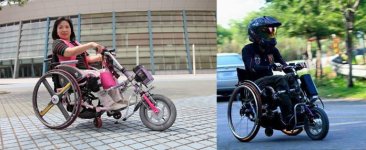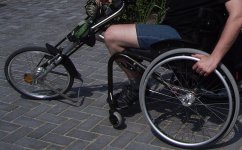spdas
100 W
Aloha all. A newbee here with lotsa questions, but I will limit it to 2.
I have converted my Toyota Yaris to electric, so I am not totally ignorant about controllers, motors, Lithium, but need a quick course in building my "Clip-on hub-motor" attaching to my wheelchair.
I just bought a cheap (relatively) Chinese handcycle (in the Pix below) with the 36v 350W hub motor with 12" wheel that goes 15mph, mostly as a test to see if it would be useful and I LOVE it but need to make it safer and faster as well as beef up the wheelchair for safety.
Here's a couple of questions:
1) looking at the hub motors on ebay, probably 500w, how do I judge which is faster? I assume it is the RPM @ given voltage..... some are around only 36v 290 rpm. That will be slower than my current 350w with (calculated 400rpm)
What kind of RPM should I be looking for or how do I judge to get to the desired speed of 20-25 mph, using a larger 16" wheel. (20" and up are too large for my application)
2) Brushless motors... does that mean that they are all "Hall-effect"?
(not that is not me on the left)
Thanks, Francis
I have converted my Toyota Yaris to electric, so I am not totally ignorant about controllers, motors, Lithium, but need a quick course in building my "Clip-on hub-motor" attaching to my wheelchair.
I just bought a cheap (relatively) Chinese handcycle (in the Pix below) with the 36v 350W hub motor with 12" wheel that goes 15mph, mostly as a test to see if it would be useful and I LOVE it but need to make it safer and faster as well as beef up the wheelchair for safety.
Here's a couple of questions:
1) looking at the hub motors on ebay, probably 500w, how do I judge which is faster? I assume it is the RPM @ given voltage..... some are around only 36v 290 rpm. That will be slower than my current 350w with (calculated 400rpm)
What kind of RPM should I be looking for or how do I judge to get to the desired speed of 20-25 mph, using a larger 16" wheel. (20" and up are too large for my application)
2) Brushless motors... does that mean that they are all "Hall-effect"?
(not that is not me on the left)
Thanks, Francis



